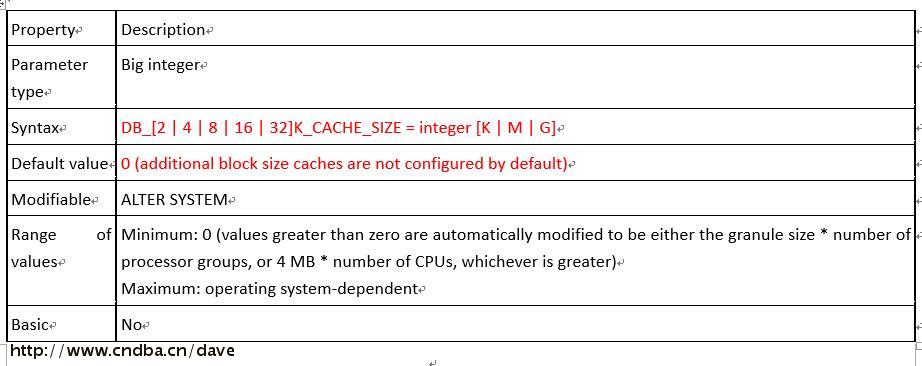1 参数说明
数据库的默认块大小受参数db_block_size控制,一般在建库时都是使用默认的8k 块。但Oracle 支持配置Multiple Block Sizes。
SQL>show parameter cache_size NAME TYPE VALUE ------------------------------------ ----------- ------------------------------ client_result_cache_size big integer 0 db_16k_cache_size big integer 0 db_2k_cache_size big integer 0 db_32k_cache_size big integer 0 db_4k_cache_size big integer 0 db_8k_cache_size big integer 0 db_cache_size big integer 0 db_flash_cache_size big integer 0 db_keep_cache_size big integer 0 db_recycle_cache_size big integer 0 SQL> SQL> show parameter db_block_size NAME TYPE VALUE ------------------------------------ ----------- ------------------------------ db_block_size integer 8192
如果要配置Multiple Block Sizes,就需要配置db_nK_cache_size 参数,这些参数默认都是0. 配置完这些参数之后,我们在创建相关的表空间时,就可以指定对应的block。 这样就完成了Multiple Block Sizes。 但是,Multiple Block Sizes 给管理上代理一定的复杂度,除非是VLDB系统的需求,OLTP中一般不使用该特性。
注意:
在创建非db_block_size 标准的表空间时,必须先修改对应的DB_nK_CACHE_SIZE 参数,否则会报:
ORA-29339: tablespace block size xxxx does not match configured block sizes
1.1 DB_BLOCK_SIZE
Caution:
Set this parameter at the time of database creation. Do not alter it afterward.
DB_BLOCK_SIZE specifies (in bytes) the size of Oracle database blocks. Typical values are 4096 and 8192. The value of this parameter must be a multiple of the physical block size at the device level.
The value for DB_BLOCK_SIZE in effect at the time you create the database determines the size of the blocks. The value must remain set to its initial value.
For Real Application Clusters, this parameter affects the maximum value of the FREELISTS storage parameter for tables and indexes. Oracle uses one database block for each freelist group. Decision support system (DSS) and data warehouse database environments tend to benefit from larger block size values.
Note:
(1)32-bit operating systems support a maximum DB_BLOCK_SIZE value of 16384(16k)
--32位系统,db_block_size 最大16k
(2)64-bit operating systems support a maximum DB_BLOCK_SIZE value of 32768(32k)
--64位系统,db_block_size 最大32k
1.2 DB_nK_CACHE_SIZE 参数

DB_nK_CACHE_SIZE (where n = 2, 4, 8, 16, 32) specifies the size of the cache for the nK buffers. You can set this parameter only when DB_BLOCK_SIZE has a value other than nK. For example, if DB_BLOCK_SIZE=4096, then it is illegal to specify the parameter DB_4K_CACHE_SIZE (because the size for the 4 KB block cache is already specified by DB_CACHE_SIZE).
-- DB_nK_CACHE_SIZE 参数指定nK 的buffer,在指定cache时,要确保有足够的空间。 不能和DB_BLOCK_SIZE 参数冲突,n 可以取2,4,8,16,32.
Do not set this parameter to zero if there are any online tablespaces with an nK block size.
Operating system-specific block size restrictions apply. For example, you cannot set DB_32K_CACHE_SIZE if the operating system's maximum block size is less than 32 KB. Also, you cannot set DB_2K_CACHE_SIZE if the minimum block size is greater than 2 KB.
-- DB_nK_CACHE_SIZE要操作系统支持,如果n=32,但操作系统支持,也是不行的。
See Also:
Your operating system-specific Oracle documentation for more information on block size restrictions
2 测试
测试环境:
SQL> select * from v$version; BANNER CON_ID -------------------------------------------------------------------------------- ---------- Oracle Database 12c Enterprise Edition Release 12.1.0.2.0 - 64bit Production 0 PL/SQL Release 12.1.0.2.0 - Production 0 CORE 12.1.0.2.0 Production 0 TNS for Linux: Version 12.1.0.2.0 - Production 0 NLSRTL Version 12.1.0.2.0 - Production 0 SQL> show pdbs CON_ID CON_NAME OPEN MODE RESTRICTED ---------- ------------------------------ ---------- ---------- 2 PDB$SEED READ ONLY NO 3 PDB1 READ WRITE NO 4 IM READ WRITE NO SQL> --查看db_block_size SQL> show parameter db_block_size NAME TYPE VALUE ------------------------------------ ----------- ------------------------------ db_block_size integer 8192 --查看操作系统系统 [root@cndba.cn ~]# lsb_release -a LSB Version: :base-4.0-amd64:base-4.0-noarch:core-4.0-amd64:core-4.0-noarch:graphics-4.0-amd64:graphics-4.0-noarch:printing-4.0-amd64:printing-4.0-noarch Distributor ID: OracleServer Description: Oracle Linux Server release 6.4 Release: 6.4 Codename: n/a [root@cndba.cn ~]# uname -r 2.6.39-400.17.1.el6uek.x86_64 [root@cndba.cn ~]# --查看db_32k_cache_size值 SQL> show parameter db_32k_cache_size NAME TYPE VALUE ------------------------------------ ----------- ------------------------------ db_32k_cache_size big integer 0 -- 指定32k: SQL> alter system set db_32k_cache_size=1M scope=both; System altered. SQL> show parameter db_32k_cache_size NAME TYPE VALUE ------------------------------------ ----------- ------------------------------ db_32k_cache_size big integer 16M SQL> 这里虽然指定的是1M,但实际上,该参数根据默认的规则进行了调整(4*CPUS)。 先创建一个16k block的表空间进行测试: SQL> select file_name from dba_data_files; FILE_NAME ---------------------------------------------------------------------------------------------------------------------------------- /u01/app/oracle/oradata/dave/system01.dbf /u01/app/oracle/oradata/dave/sysaux01.dbf /u01/app/oracle/oradata/dave/undotbs01.dbf /u01/app/oracle/oradata/dave/users01.dbf /u01/app/oracle/oradata/anqing.dbf SQL> create tablespace tbs16k datafile '/u01/app/oracle/oradata/16ktbs.dbf' size 10M blocksize 16k; create tablespace tbs16k datafile '/u01/app/oracle/oradata/16ktbs.dbf' size 10M blocksize 16k * ERROR at line 1: ORA-29339: tablespace block size 16384 does not match configured block sizes
这里只是演示一下错误。
我们创建32k的表空间进行测试:
SQL> create tablespace tbs32k datafile '/u01/app/oracle/oradata/32ktbs.dbf' size 30M blocksize 32k; Tablespace created. --创建一个测试表,放到32k的表空间上 SQL> create table tt32k tablespace tbs32k as select * from dba_objects; Table created. --验证一下表tbs32k的block 大小 SQL> col segment_name for a15 SQL> select segment_name,blocks from dba_segments where segment_name='TT32K'; SEGMENT_NAME BLOCKS --------------- ---------- TT32K 384 --当表的每个block 越大时,那么它里面就能够存放更多的block --我们使用8k的block 来创建一个相同的表,来查看它使用blocks,从而进行对比 SQL> create table tt8k as select * from dba_objects; Table created. SQL> select segment_name,blocks from dba_segments where segment_name='TT8K'; SEGMENT_NAME BLOCKS --------------- ---------- TT8K 1536
对比看到,对于同样记录数的表,使用32k的blocksize是384个blocks,使用8k是1536个blocks。
所以在VLDB中,在使用大Block size的情况下,如果是顺序读,可以明显改善读的性能。 因此在VLDB 或者DDS系统中可以考虑使用Multiple Block Size,但是在OLTP中,不建议使用。
版权声明:本文为博主原创文章,未经博主允许不得转载。





